by franz
INTRODUCTION
This circuit combines the traditional N7 route to the South, then loops back via a different route via the train to the East Coast, and the Pangalanes Canal.
HIGHLIGHTS
Ranomafana, Isalo, and Andasibe National Parks, Fianarantsoa-East Coast train, Pangalanes Canal from Mananjary to Mahanoro
DAY 1: FLIGHT TO ANTANANARIVO
Arrival in Tana, meet and greet at the airport then transfer to your hotel. Night at hotel.
DAY 2: TANA – ANTSIRABE – AMBOSITRA
After breakfast, drive towards Ambositra.. Still in the Highlands with its green landscapes dominated by terraced rice fields and pine and eucalyptus forests. One thing which marks the Highlands is its architecture. Almost all houses are made from brick, with ornately carved wooden balconies and shutters with nice colours. Before Ambositra is the ” col de tapia” where the Tapia tree grows, a type of tree which resists bush fires. Arrival in Ambositra, a city known for its wood carving and its numerous small handicraft workshops. If time permits, we visit a workshop where one can attend craftsmen working. Night in hotel on B&B.
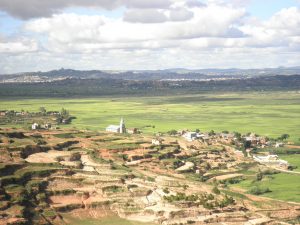 DAY 3: AMBOSITRA – ANTOETRA
DAY 3: AMBOSITRA – ANTOETRA
Today we continue for 30 minutes on the RN7 till Ivato centre, there we leave the National 7 and take a 15km track (about 1 hour) to reach Ambaladingana where Sous Le soleil de Mada is located. From there, we’ll start our different hikes. Night in hotel on B&B.
DAY 4: ANTOETRA – RANOMAFANA
After breakfast, continuation to Ranomafana, which will be reached within 3 hour. The landscape is now changing into a greener one, with a tropical forest on the both sides, sometimes interrupted by small villages selling bananas or charcoals. The national Park of Ranomafana was created in 1991. It has 40,000 ha of superficies and consists of a series of steep hills from which numerous small streams run into the river Namorona, which tumbles down the valley in a series of waterfalls and rapids. Arriving in Ranomafana late in the afternoon. Night in hotel on B&B.
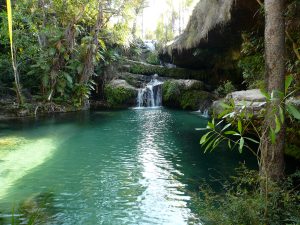 DAY 5: RANOMAFANA NATIONAL PARK
DAY 5: RANOMAFANA NATIONAL PARK
It is situated in the eastern part of Madagascar, 800m to 1200m altitude, with a surface of 41.000 ha consisting of a series of steep hills and numerous small streams running into the Namorona River. Created in 1991, Ranomafana National Park consists of one of the richest rain forests of the country: more than 70% of the park is still primary rainforest, despite heavy exploitation of the forest in the past. 278 species of trees and bushes ‘(81 of which are endemic) and numerous other species of smaller plants or medicinal plants have been recorded. In the higher areas, the trees are festooned with mosses and lichens, many fern trees. The secondary forest is dominated by the introduced trees and giant bamboos. Orchids such Bblophyllum and Eulophiella are abundant with ferns tree, palms, mosses, a variety of flowering wild plants. It is also the most important site of lemurs in Madagascar, 12 species have been recorded and it is until now the only confirmed site for the two rarest species: the greater bamboo lemur Hapalemur simus and the golden bamboo lemur Hapalemur aureus. The striped civet: FOSA, scientifically called “Cryptoprocta ferox” might be seen, 29 species of mammal, 98 species of birds representing 38 families in which 68 species are endemic to Madagascar have been recorded. More than 5 species of chameleons, one of which Brookesia superciliaris, is a special one as it has the same color of the dead leaves on the forest floor. Insects are of exceptional interest, like the bizarre Giraffe-weevil scientifically known as Trachelophorus Giraffa. Steep mountains, dramatic waterfalls and natural hot springs make this endangered and exotic forest charming and unusual. The name Ranomafana means «hot water «it has a thermal pool where visitors can relax. Night in hotel on B&B.
 DAY 6: RANOMAFANA – ISALO: 245 km : 6 to 7 hours
DAY 6: RANOMAFANA – ISALO: 245 km : 6 to 7 hours
Morning, we’ll have 1 hour drive to Fianarantsoa, the capital of Betsileo tribes, the second largest tribe of the Highlands, also the second most populated city of the country after Antananarivo. From there, 60mn drive to Ambalavao and visit the “Anteimoro paper” workshop; Paper making was introduced in Madagascar by Arab traders. Then we’ll visit ANJA, a park run by the local community where part of the income serves to pay the teachers of the local school. We will spot ringtail lemurs during our 2 hours hike inside the park. We’ll head on to Ihosy, the capital of Bara tribes, through the mountain chain of Andringitra, which serves as a transition between green Highland and the dry South. The landscape is more and more grandiose. Huge Granite blocks are marking the spacious and empty plains. It is ” the gate of the south ” which marks the end of the Highlands and the beginning of the South. We feel like being swallowed by this emptiness, as we pass through the “plateau de Horombe” with its spacious red soil, reminding us of ” no man’s land”. In various places we can see zebu herds, accompanied by Bara men with rifles. Arrival in Isalo at the end of the afternoon. Night in hotel on B&B.
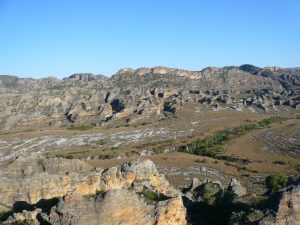 DAY 7: ISALO NATIONAL PARK: Piscine Naturelle and Canyon des singes
DAY 7: ISALO NATIONAL PARK: Piscine Naturelle and Canyon des singes
The park covers an area of 81,540 ha comprising the entire stretch of the Isalo massif. A spectacular landscape with its eroded sandstone massif, cut by deep canyons, making it the most breathtaking scenery and the most visited national park of the country. It reminds us of the landscape of “the grand canyon” in the USA, with its yellow, red and brown like colours and its eroded form. The massif is also the place where the Bara bury their dead first in temporary graves, then into defintive tombs. What is special with this park is how nature seems to be in harmony. It’s amazing to find how plants have adapted to the harsh and dry climate of Isalo. We will see pachypodium, aloes, which grow in the rocks. These plants have a special roots and trunks where they store water when it rains. Then they can live without water for many months. For animal lovers we’ll see ring-tailed and brown lemurs, many sorts of lizards, chameleons.
. Then around 04.30, visit the “ fenêtre de l’Isalo” for the sunset. Back and Night in hotel on B&B.
DAY 8: ISALO – TULEAR – IFATY
After breakfast, head on to Tuléar, the terminal of the National road N° 7. After 1 hours drive, stop in Ilakaka, a tiny village transformed into a busy town since the discovery of sapphire 15 years ago. From there, 1 hour drive to reach Zombitse National Park where you have 1 hour hike with a special guide in a semi-dry tropical forest, home to few endemic birds and 6 species of lemurs. From here, a new scenery arises, composed with semi-dry forest of the west, baobabs and the thorny bush of the south. On the way, one can also admire the colorful tombs of Mahafaly and Antandroy tribes. Arrival in Tuléar at the end of afternoon. City tours of Tuléar then continuation to Ifaty which is situated in the Deep South. We will cross the dry and sandy soil where local people suffer for the lack of drinking water. The landscape will be dominated by the spiny forest like the cactus, different euphorbiacea and didieracea. Many mangrove trees are lining along the coast alternated by Vezo villages which earn their living on fishing. Night in hotel on B&B.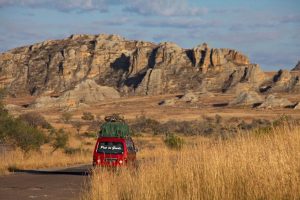
DAY 9 – 10: IFATY
Day off. Ifaty lies on the north of Tuléar. Situated in the largest lagoon of the country, it is an ideal place for relaxing. Many excursions are possible on the spot like whales watching or sea excursion with local boat. From July to mid September, whales are coming to the cool sea of Madagascar to give birth. It is a very spectacular experience as sometimes we will see the whales very near our boat. Situated in the largest lagoon of the country, Ifaty is also protected by a large coral reef which makes it an ideal place for diving and snorkelling. In the afternoon we can walk to the village of Mangily where we can have an experience off the Vezo Fishermen’s life, especially when the fishermen come back from fishing.
Visit of “ Spiny forest” the forest typically from the south where we will find some Baobab samples and another special trees.
Night in the same hotel on B&B.
DAY 11: IFATY – ISALO : 247 km
After breakfast, we drive to Ranohira that we’ll reach within 4 hours. Our first stop is in Tuléar where we’ll have a short city tours. From there, we take the National 7 and head northwards on to Isalo. This step brings us to the interior part of Madagascar, the land of Mahafaly. Along the way well see many tombs of these tribes. We enter the Andranomaintso zone and we pass through the national park of Zombitse, a remaining of the western semi dry forest which serves as a transition zone between the dry south and the land of Isalo, a formation of continental sandstone rocks. Arrival in Isalo by the beginning of the afternoon.
Settling and overnight in our hotel on B&B.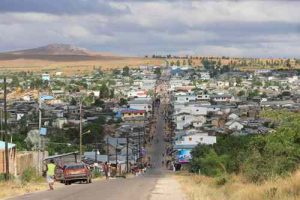
Day 12: ISALO – FIANARANTSOA
Drive northward to Ambalavao. Today we enter the rocky mountain chain of Andringitra which is very picturesque remaining of Arabian civilisation. Then the landscape changes when we enter the highland, we cross the “Gate of South” which serves as a transition between the south and the fresh and green highland. Stop and visit to Anja Park, a community based park run by the village which income serves to pay the teacher of the local primary school. Anja park which is home to many families of lemurs catta. Then we visit Iharintsena village, a community based tourism where some of the locals have transformed their house to accommodate tourists. We head on to Ambalavao to visit the famous “ Papier Anteimoro” and wine tasting to Soaviata, a wine factory. We continue to Fianarantsoa the second city of the country. It is the centre of the catholic religion so almost the best school are found there. Called “the gate of the South” Fianarantsoa is the capital of Betsileo tribes. This is the seat of Jesuits and the best university is found there . Besides, Fianarantsoa means ” Place of good learning”, as the Betsileo were taught by the Merina governors during 19th Century to behave in a good and civilian way. Short city tours of Fianarantsoa which is build in the same way as Antananarivo, with its 3 different stages.
Night at hotel on B&B.
DAY 13: FIANARANTSOA – MANAKARA
Train to Manakara
This journey goes through the green landscape of the east, past mountains and numerous small rivers and streams. During this train journey we will see a couple of the remaining primary tropical forests. The train stops in nearly every village on the way, where we can come in contact with the local people who are bringing there goods on the train or are trying to sell things to the travelers.
arrival in Manakara, the capital of coffee, we will have a short city tour to give you an idea of the city. Manakara is the terminal of the Panagalane channel, situated on the beach, this city used to be a big harbor during the colonial period. We can still see some evidence of this in the form of some colonial houses. Night at the hotel on B&B.
DAY 14: MANAKARA – MANANJARY
In the morning we continue to Mananjary, a drive of about 4-5 hours alongside tropical greenery. Along the way you will see travelers palm, its leaves spreading out like a fan. The area through which we ride is known for the gold that is mined there. In the villages you see women with gold teeth, the sign of wealth. Night at the hotel on B&B.
DAY 15: MANANJARY
Day free. Located between the beach and the Canal des Pangalanes, Mananjary was once the headquarters for the south-east of Madagascar.
With its lush vegetation, you will find everything from vanilla to garlic,cinnamon to coffee, and of course pepper. The trade route along the east
coast of Madagascar is also called the spice road. Night at the same hotel on B&B.
DAY 16: MANANJARY – NOSY VARIKA
As we will have a long navigation with a flat bottom motor boat today, well have to leave early at 06.00 and have our breakfast on board between 07.00 to 08.00. Our destination is Nosy Varika, 98 km from Mananajary along the Canal des Pangalanes. As we are sailing against the wind, also with some police controls on the way, the length of the sailing time, including the visit varies from 10 to 12 hours. Arrival in Nosy Varika late in the afternoon. Night in a very simple and basic hotel on B&B
DAY 17: NOSY VARIKA – MAHANORO
Departure at 06:00 and we navigate between 8 and 10 hours further north, till Mahanoro the end of our journey with our flat bottom-boat. Breakfast will be served on board between 07.00 08.00. Today we will have some difficulties on the Pangalanes as the water is sometimes too shallow which makes navigation very difficult then the crew should paddle instead of using the engine. The canal, in this area without roads, is the only way to get anywhere so alongside the canal, we’ll meet local fishermen, families using pirogue and many “boat brousse” transporting goods and passengers, also people doing their shopping on the boat. All local life is based on the canal; their daily activities take place on the canal: women doing their washing, their dishes, having a bath, children swimming or playing merrily with geese and ducks, men fishing with large nets. Then continue to Mahanoro that well reach by the end of the afternoon ( around 17.30). It is the place where the navigable part of the canal ends and where the canal meets the sea. The houses we stay in are close to the beach. Swimming in the sea is not advisable because of strong currents. Night in a very simple and basic hotel on B&B.
Day 18: MAHANORO – ANDASIBE
After breakfast, drive to Andasibe. We stop at Brickaville, a small city very famous for its sugar cane and orange plantations. Brickaville is also a stopping place for travellers on taxi-brousse to Tamatave. There a car is waiting to bring us to Andasibe through the green and luxuriant vegetation of the east, Night in Hotel on B&B.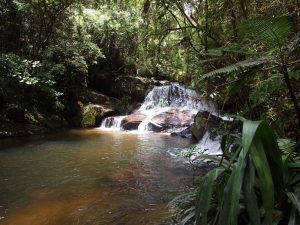
Day 19: ANDASIBE
Morning visit of the Special Reserve of Andasibe, to see the Indri Indri the biggest lemurs of the island. This 810 ha reserve is a very unique with endemic fauna and flora. It contains a wide variety of orchids, canopy, animals like chameleons, tenrecs, and many birds. In the afternoon, we will visit the private reserve of Vakôna where we find four speces of lemurs and other animals. In the end of the afternoon, visit of a Betsimisaraka (The-Many-inseparable) village, the second largest tribe. Night in the same hotel on B&B.
Day 20 : ANDASIBE- TANA
Breakfast at hotel, then head on to Tana. It takes 3 to 4 hours’ drive to reach the capital.We’ll drive through the winding road of the National 2. Green landscape, composed with tropical rainforest, alternated with eucalyptus and pine, hills, valleys, lakes and rivers, villages with huts, bricked house with thatched roof are the scenery we will see along the way. Optional stop at Pyereras Park for 1 to 2 hours visit of this farmed Reptile park. Arrival in Tana. Overnight in Hotel on B&B.
Day 21 : TANA – FLIGHT OUT
Breakfast at hotel, then transfer to the airport for the flight your international flight back home.
END OF SERVICE
INCLUDED:
• Transfer Hotel / Airport / Hotel
• Accommodation in a double room according to the above program
• Boat Mananjary – Nosy Varika – Mahanoro
• Entrance fees with local guide for the parks mentioned in the program
• Transport with a private car during the trip
• English speaking guide during the trip
NOT INCLUDED
All excursions which are not in the program.
All personal expenses, drinks, laundry, tips,insurance
All flights and taxes
Recommended Posts
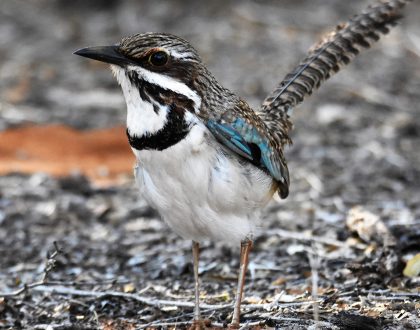
21/ Special interest – Birding tour in Madagascar
August 6, 2018
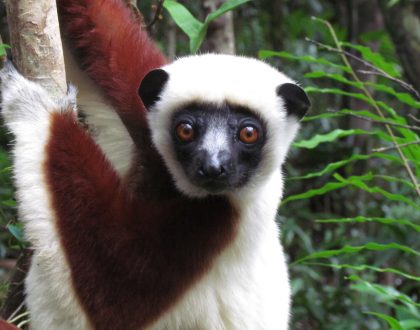
Madagascar Northern Untamed : 14 nights – 15 days
July 17, 2018
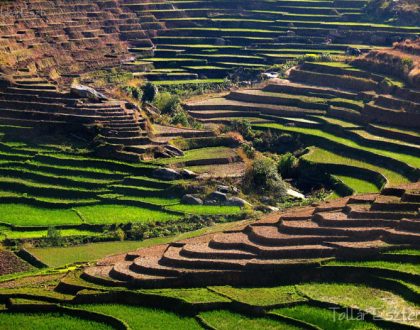
31/ Madagascar for landscape photographers
May 28, 2018
